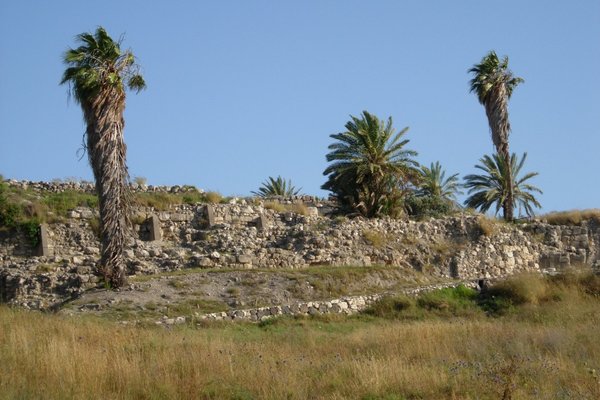Israel
Biblical Tells
Biblical Tels - Megiddo, Hazor, Beer Sheba are historic settlement mounds with biblical connections.
The cities dated to the Bronze and Iron Age, and flowered from the 12th to 6th century BCE. They show early urban development in the Levant by a centralized authority that had control of trade routes. The tels hold remains of palaces, fortifications and water collection technologies.
Community Perspective: Megiddo is the most interesting of the three, displaying a sunken grain silo, a huge water cistern, and a water tunnel.
Site Info
Official Information
- Full Name
- The Biblical Tells and Ancient Water Systems -- Megiddo, Hazor and Beer Sheba (ID: 1108)
- Country
- Israel
- Status
-
Inscribed 2005
Site history
History of Biblical Tells
- 2005: Inscribed
- Inscribed
- Type
- Cultural
- Criteria
- ii
- iii
- iv
- vi
Links
- UNESCO
- whc.unesco.org
- Official
-
- en.parks.org.il — Tel Beer Sheva
- en.parks.org.il — Tel Megiddo
- en.parks.org.il — Tel Hazor
- Related
-
- bibleplaces.com — Hazor
- crystalinks.com — Hazor tablets
- micro5.mscc.huji.ac.il — Hazor excavation project
All Links
UNESCO.org
- whc.unesco.org — whc.unesco.org/
Official Website
- en.parks.org.il — Tel Beer Sheva
- en.parks.org.il — Tel Megiddo
- en.parks.org.il — Tel Hazor
Related Resources
- bibleplaces.com — Hazor
- crystalinks.com — Hazor tablets
- micro5.mscc.huji.ac.il — Hazor excavation project
News Article
- Dec. 22, 2020 jpost.com — Sweet-toothed Canaanites imported exotic foods to Israel 3,600 years ago
- July 28, 2019 jpost.com — Staircase of 3500 years old biblical palace revealed in Tel Hatzor
- July 26, 2016 jpost.com — Egyptian statue unearthed in Tel-Hazor
- July 10, 2013 mfa.gov.il — Sphinx of ancient Egyptian king found in Tel Hazor
- Aug. 3, 2012 biblicalarchaeology.org — Recent discovery of massive jars of scorched wheat at Canaanite Tel Hazor
Community Information
- Community Category
- Archaeological site: Near Eastern
Travel Information
Israel and Palestine Hotspot
Recent Connections
-
Perfect Inscriptions
2005 -
In the Israel Museum
Cultic objects from the “Shrine of the … -
Excavated by the Deutsche Orient-Gesellschaft
Megiddo
Connections of Biblical Tells
- Individual People
-
-
King Solomon
Megiddo reached its peak under King Solomon in the 10th century BCE - he rebuilt the city (as mentioned in the Bible) -
John D Rockefeller Jr
Megiddo. As per Ancient Thebes the excavations by the Chicago Oriental Institute were funded by Rockefeller between 1925 and 1939. He visited the dig in 1929 and founded the Rockefeller Museum in Jerusalem at a cost of $2 million to display the finds from there and elsewhere in the "Holy Land" -
Viscount Edmund Allenby
Took the title "Viscount Allenby of Megiddo and Felixstowe" when he was enobled on 7th Oct 1919. The reference to Megiddo commemorated his victory over the Ottoman army at the Battle of Megiddo 19-25 Sept 1918. Despite its title the battle covered a far wider area than that of Megiddo but did actually involve a skirmish on the Tel itself seeSee www.tau.ac.il
-
- Trivia
-
-
In the Israel Museum
Cultic objects from the “Shrine of the Stelae”See www.imj.org.il
-
- History
-
-
Canaanite cultures
-
Amarna Letters
Hazor and Megiddo -
Bronze Age Collapse
In particular Meggido and Hazor – See -
Oldest Buildings
3500-2200BC "Settlement on Tel Megiddo covers four main periods. The earliest settlement during the Neolithic period is revealed by pottery finds in caves, and habitation sites within stonewalls" (AB). However the earliest visible remains date to the Early Bronze age "The Early Bronze monumental temple is the best manifestation of the first urbanisation process in the Levant (Nom File) -
Bronze Age
Criti iii: "The three tels are a testimony to a civilization that has disappeared - that of the Cananean cities of the Bronze Age" (OUV) -
Via Maris
Hazor/Megiddo -
Assyrian Empire
"The independent Kingdom of Israel ended in the 8th century BC with conquest by the Assyrians, who largely destroyed the tel towns. Both Beer Sheba and Hazor were immediately abandoned; some settlement persisted at Megiddo until the early 4th century, when it, too, was finally abandoned." (AB ev) -
Excavated by the Deutsche Orient-Gesellschaft
Megiddo -
Historical Food Remains
Wheat grains at Tel Hazor -
Sieges and Battles
The Battle of Hazor (Old Testament)
-
- Architecture
- Damaged
-
-
Destroyed during invasion
Megiddo, Hatzor -
Destroyed or damaged by Earthquake
Many artifacts from Tell Hatzor were damaged/destroyed in an earthquake in 2008
-
- World Heritage Process
-
-
First sites filling gaps cited by ICOMOS
traditional irrigation 2005
-
Reconstruction regarded as unsatisfactory
Tel Beersheba: "In places, and notably at the main gate, there has been considerable reconstruction of walls, and in particular the upper, mud-brick, portions. This gives a somewhat spurious impression of completeness, the more so since in some cases the walls have been reconstructed to an equal height. A different policy would be appropriate in future." (AB ev) -
Perfect Inscriptions
2005
-
- Religion and Belief
-
-
Mentioned in the Bible
Meggido - Josh 12:21, Judg 1:27, 1 Kings 4:12, 9:15- Canaanites to Solomon; 2 Kings 29, 2 Chr 35:29, Zech 12:11 - Josiah killed fighting the Pharaoh; Hazor - Josh 11:1/10-13 - taken by Joshua; Josh 19:36, Judg 4:2, 1 Sam 12:9 - Taken again by Barak ; 1 Kings 9:15 fortified by Solomon; 2 Kings 15:29 - taken by Assyrians, Beer Sheba - Gen 21:31/2/3, 22:19, 26:33, 28:10 - Abraham, Isaac, Jacob; Jos 19, 1 Chr 4;28 Tribe of Simeon; Judg 20:1, 1 Chr 21:2, 2 Sam 24:2 - "Dan to Beersheba" as the "Promised Land" -
Jewish religion and culture
-
Prophecies
The battle of Armageddon (site of the final battle between God and Satan) at the Megiddo
-
- Human Activity
-
-
Famous Archaeological Trenches
Megiddo - "Schumacher's Trench" "His main excavated area at Megiddo was a trench 20–25 metres (66–82 ft) across, running north-south through the center of the mound, a method widely used in those days at the typically large sites of Mesopotamia, but considered unfortunate in this case by later archaeologist due to the very large amount of soil removed in a manner that would offer relatively little information to future scholars and excavators." (Wiki - Schumacher) -
Multilingual inscriptions
An Accadian-Sumerian dictionary discovered at Tel Hazor -
Language isolate
Sumerian dictionary has been uncovered in Tel Hazor and Sumerian is an isolate -
Olive presses
Hazor
-
- Constructions
-
-
Protective Shelters
Hatzor palace -
Stelae
Tel Hazor features many stelae now on display at the site museum. -
Tunnels
tunnels leading to underwater springs -
Aqueduct
Megiddo -
Sphinx
Part of an ancient Egyptian king's sphinx at Tel HazorSee phys.org
-
Acropolis
Megiddo - "Megiddo is a massive site, the core of which, the Tel Megiddo acropolis, is under excavation by The Megiddo Expedition of Tel Aviv University Institute of Archaeology" -
Horse Stables
Megiddo Stables -
Tell
-
Cisterns
-
- WHS on Other Lists
-
-
World Biosphere Reserves
Meggido Biosphere Reserve (Israel 2017)—Renaming of Ramot Menashe Biosphere Reserve.
-
- Timeline
-
-
Built in the 2nd Millennium BC
mainly represent the period between 12th and 6th Centuries BC
-
- WHS Hotspots
-
-
Israel and Palestine Hotspot
Israel hotspot
-
- Science and Technology
-
-
University of Chicago Oriental Institute
Meggido - "The World's first million dollar excavation". The OI excavated 1925 - 1939 when money ran out. The intention had been to do a complete excavation across the 8 discovered levels. Many of the finds are in Chicago - among the most famous are the Megiddo Ivories which are shared with the Rockefeller museum in Jerusalem -
Excavated by American Universities
Chicago Univeristy excavated Megiddo
-
- WHS Names
-
-
Name changes
From "The Biblical Tels and Ancient Water Systems - Megiddo, Hazor, Beer Sheba" to " "The Biblical Tels - Megiddo, Hazor, Beer Sheba". Following Israel's decision during evaluation not to pursue the OUV aspects related to the Water Systems
-
News
Recent Visitors
Visitors of Biblical Tells
- AC
- Alberto Rodriguez Gutierrez
- Alexander Lehmann
- A. Mehmet Haksever
- AndreaTLV
- Anna Wludarska
- Argo
- Assif
- Atila Ege
- BaziFettehenne
- Bram de Bruin
- Cezar Grozavu
- Cholden324
- Christravelblog
- Corinne Vail
- ctravel
- CynthiaW
- Daniela Hohmann
- Daniel Chazad
- Danny L
- DavidS
- Dennis Nicklaus
- Dimitar Krastev
- Dirk-pieter
- Erik Jelinek
- Eva Kisgyorgy
- Evgenii
- Fan Yibo
- Filip Murlak
- GabLabCebu
- Gary Arndt
- Grzegorz Andruszkiewicz
- Harry Mitsidis
- Iain Jackson
- Ilya Burlak
- Ivan Rucek
- jacob76
- Jana and Matt
- janem
- Jarek Pokrzywnicki
- Jawnbeary
- Jay T
- Jens
- JL
- John Smaranda
- Jonas Hagung
- k2flake
- Karito Vies
- KateY
- kjluebke
- Knut
- Lameduck99
- Lara Adler
- Lars Bogstad
- Lucio
- Luis Filipe Gaspar
- Lukasz Palczewski
- lynnz317@aol.com
- Maciej Gil
- Malgorzata Kopczynska
- Martina Rúčková
- MaYumin
- mg:1
- Michael Novins
- Mikan22
- Mikko
- Milan Jirasek
- MMM
- Monica Tasciotti
- nan
- Nihal Ege
- Patrik
- Petteri
- Philipp Leu
- Philipp Peterer
- Ralf Regele
- Roger Ourset
- Roman Bruehwiler
- Sergio Arjona
- sncjob
- Solivagant
- Sorel Americo
- Stanislaw Warwas
- Szucs Tamas
- Tamara Ratz
- Tarquinio_Superbo
- Tatiana Nikulnikova
- Thomas Buechler
- Thomas van der Walt
- Tom Flaten
- tony0001
- travellingcat
- Tsunami
- Valentina
- Vanessa Buechler
- Veronica
- WalGra
- Walter
- Wojciech Fedoruk
- Xiquinho Silva
- Yongcheng Liu
- Zoë Sheng
Community Reviews
Show full reviews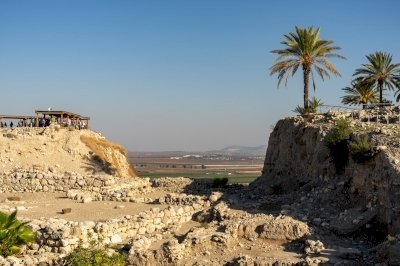
I visited two of the three inscribed tels on my tour around Israel in November of 2019. The biggest and the most popular of them is Megiddo, in the Lower Galilee. It had been settled from Neolithic times through the Bronze and Iron Ages until about 3rd century BC. Excavations in the 20th century unearthed over twenty layers of cities successively built on this site. Beyond the gates to the site, the rest of it is low wall outlines and occasional stand-alone features. A casual visitor is unlikely to be able to find enough visuals to appreciate anything more than the vague yet obvious notion that this place is really really old. There are a dozen and a half designated points of interest on the walking circuit; having them explicitly named and dated by different eras, in my opinion, is somewhat disorienting - I recognize the attempt to cover more than a single stratum of history but it clashes with the notion that many different layers were built here, when one is emphasized.
Viewpoints above the Jezreel Valley are among the highlights. At the end of the walking circuit, you can descend into the underground water capture system built during the Israelite period around 8th century BC. The tunnel guided water from a spring outside of the city boundaries to a well inside the city walls, thus offering the residents access to fresh water without having to venture beyond the walls. It is probably the most remarkable surviving artifact …
Keep reading 0 comments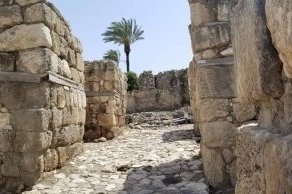
WHS#55
I visited Tel Megiddo during my travels through the Galilee in April 2019. The tel is quite imposing as I approach, as it's the lone hill on the flat Jezreel Plain. Hill look-alike, at least, because this tel is huge. It towers several meters higher than me, and walking up it really feels like walking up a small natural hill. But natural it is not. This tel is made up of 26 different layers of civilization, stretched between maybe 7 millennia all before the time of Jesus. It's been in ruins longer than San Marino has been a state, and inhabited even longer than that, so it's really a historic treasure. Anyway, a visit to the tel will always start at the gates to the city, dating back from the Late Bronze Age. For their age, the walls surrounding the passageway are surprisingly tall. Some layers of civilization have even been flattened to mere inches of thickness. This can be seen in the dug out portion where the Early Bronze Age temple, the site's most famous ruin, is located. The walls of this manmade depression still show several layers of the different cultures that have settled on this very spot. The site is really an interesting setting, with its palm trees all over the place and a view of the vast plains all around. A walk further brings me to 2 of the most impressive ruins: the grain silo and the water management system. I was actually able …
Keep reading 0 comments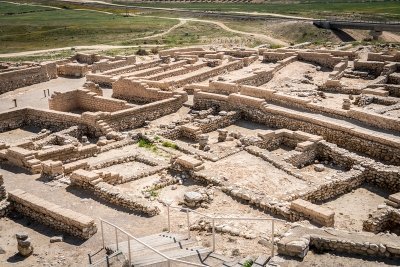
Tels are hills or mounds created over centuries by communities building over the ruins and refuse of the previous structures. Archaeologists often liken tels to a layer cake with each layer being a different period of time. As the mounds grow, they usually become narrower, which eventually leads to a shrinking of the population, and eventual abandonment of the tel. This process, however, can take centuries.
This world heritage site consists of three different tels in different parts of Israel. While there are many archaeological tels in Israel, these three were chosen for World Heritage status because, 1) they all have at least a brief mention in the Old Testament, and 2) they all have extensive human-built water systems. The water systems for all three tels are quite impressive and not obvious when you first arrive at the site as they are underground.I visited all 3 of the Biblical Tells during my 2016 trip to Israel. By far the most heavily excavated and visited is Meggido. Given its association with the Book of Revelations, it gets many religious tours who stop here on the way to Galilee. Ber Sheeba is very close to the city of the same name and gets many school groups. Hazor is the furthest away from anything and gets the least number of visitors.
Keep reading 0 comments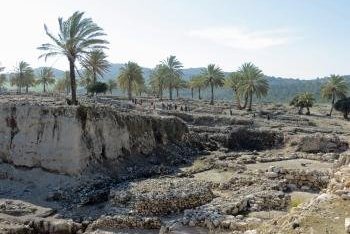
Tel Megiddo, one of the three Biblical Tells (basically towns built right on top of each other over the span of hundreds to thousands of years, forming a mound) inscribed on the World Heritage List, is a deeply excavated site rich in history. I visited this tell in February 2015 as part of group tour of Israel with my church, and it was fascinating to see how much archaeological work has been done there. Because I was on a group tour, we didn't have time to tour the site individually, nor was there much discussion about the Bronze-age history. However, we did learn about the association many archaeologists have made of this site's growth during the reign of King Solomon, to include the installation of stables. We also walked through an ancient city gate en route to the top of the hill, to get a better understanding of the tell's strategic placement between the coast and the interior of the country. This advantageous location has led to battles in Biblical times and in more modern times--almost 100 years ago during World War I. Although I didn't get to see any other tells on the group tour, Tel Megiddo was an amazing site to visit.
Logistics: Tel Megiddo can be visited by private transportation or as part of a group tour.
Keep reading 0 comments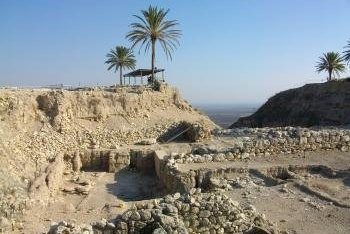
Although this WHS has three locations (in different places of Israel), I visited only one – Megiddo. Megiddo is located in the area full of World Heritage Sites, around 40 km from Haifa, if I remember correctly. Visiting Megiddo may be easily combined with another WHS – Necropolis of Bet Shearim.
The site was firts settled around 9 thousand years ago and became an important point for all groups wanting to control Lower Galilee, such as Egyptians, Kanaans and of course Jews. It is traditionally identified as apocalypic Armageddon, where the final battle between Good and Evil should take place. The site is very well preserved and even for those not interested in archeology, when the weather is good it is a picturesque place worth seeing. Most of the walls, gates, observation points and stables remained in a relatively good condition so it is not difficult to imagine how the town looked like in the biblical times. I was particularly surprised with underground water supply system, which made Megiddo practically self-sufficient during the siege. Overall, from several archeological places I have visited in Israel, I found Megiddo the most interesting.
Keep reading 0 comments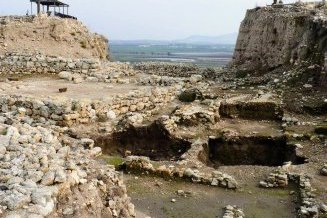
We visited all 3 Tels and didn’t find the “duplication” excessive – indeed the similarities and differences which emerged were of benefit in understanding the entire nomination. We gave Megiddo just over an hour – but ideally it needed more. Like the previous reviewer we came up against the “dragon at the desk”! We were early enough to get in but it was Shabbat and it was made clear that, even if the official closing time was 3pm, they really wanted us out at 2.45. Also the Water Tunnel closed at 2.30. Hazor took 50 minutes (but the water system unfortunately was closed because of roof falls – who knows when it will reopen). Finally, Beersheba took about an hour – but that was extended by our conversation with one of the young volunteers working on the site.
There are 2 background issues concerning these sites which it is perhaps worth bringing out at this point
a. They were originally nominated on 2 different sets of criteria. For their “Biblical Associations” under ii, iii, iv and vi and for their “Water Systems” under i, ii and iii. During the evaluation Israel asked that this second set not be considered and agreed to change the nominated name from “The Biblical Tels and Ancient Water Systems of …” to merely “The Biblical Tels of …”. Why this happened isn’t made clear in the AB evaluation. The Water systems do however represent a major aspect …
Keep reading 0 comments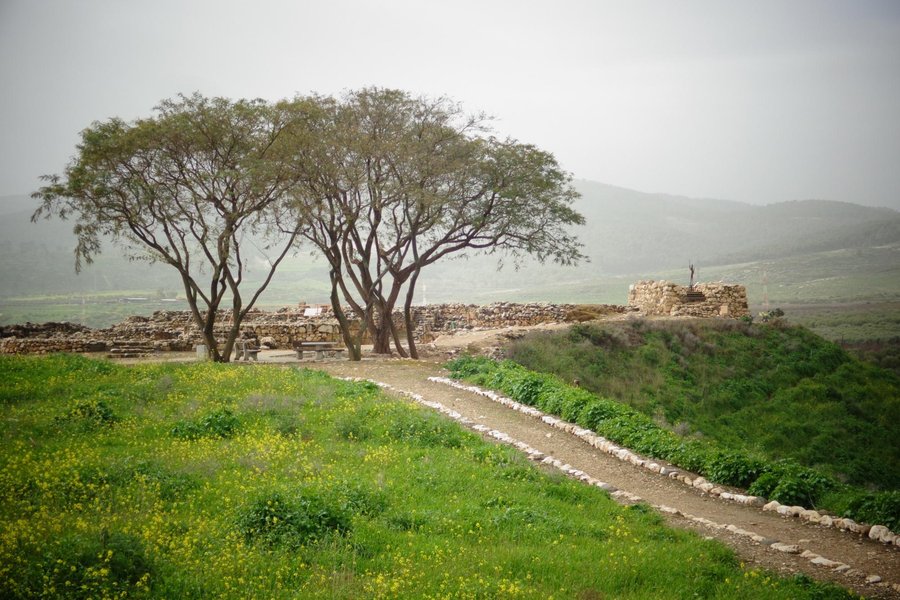
I visited Megiddo and Beer Sheba. For Megiddo I needed to go twice, as unlike written in the lonely planet the site closed at 3pm! And the cold hearted lady would not let me in at 3.30pm. The site itself is rather unspectacular compared to Masada or Mamshit, but one can imagine how the city must have looked like. The highlight is the accessible irrigation system. Megiddo is about 30min drive from Haifa and easy accessible. Due to its proximity to the Haifa hotspot (Haifa, Acre, Carmel caves) I suggest Megiddo for all visitors with limited time resources.
Beer Sheba is smaller than Megiddo, but equally few is left. There is an observation tower in the middle and again the highlight is the irrigation system. My visit was quite pleasant and makes a good stopover on the Tel Aviv - Eilat route.
Keep reading 0 comments
Hatzor user to be a major city spread over an area of 800 Dunam. The site is very much like the one in Megiddo (Armageddon) only larger. It retained an unbelievable underearth water cisterns which for me is the most remarkable discovery at the site. The landscape is beautiful as well. There is a nearby museum of the site at Ayelet Hashahar which was unfortunately closed on our visit.
Keep reading 0 comments
Megiddo is situated on a hill overlooking the Yizrael Valley. The view is beautiful. The site is one of the most important ones in Israel. I found it a bit diappointing though. There isn't so much left of the city (which is typical for such early sites) and the most interesting artifacts were taken away either to the Rockefeller Museum in Jerusalem or to the University of Chicago which was responsible for digging the site. The part best preserved is the water tunnel which is remarkably impressive. It requires some effort in descending about 200 steps but the effort is certainly worthwhile.
Keep reading 0 comments
We have visited all three of the listed tels in Israel, plus many more besides. These three all share the fact that the sites were first settled around 5000 years ago, and have experienced multiple layers of occupation since then; in the case of Hazor and Megiddo, around 20 layers, and Beersheeba about 9 layers.
Tel Hazor is the most northerly, located near Rosh Pinnah. Buses heading north towards Kiryat Shmona and Metulla can drop you at the access road, but do not get confused with Hazor kibbutz which is several kms south. It is a hot, dry and dusty site most of the time, but there are a number of excavations opened up. To find some shade at the site, you can descend into the water works chamber. There is an interesting museum a short distance away.
Har Megiddo (Mount Megiddo or Armageddon) overlooks the Jezreel Valley, and is best accessed by buses travelling between Haifa and Afula. We have been here several times and continue to find it fascinating. Of particular interest are the sunken grain silo, the huge water cistern, and the tunnel (which you can walk through in the shade) which leads to a spring outside the defensive wall. An important occupier was King Solomon, abouth three thousand years ago, who had most of the structures built that can be seen today. The most recent occupiers were the British forces during the First World War.
Tel Beersheeba, is about 5km away from the modern city of …
Keep reading 0 comments
